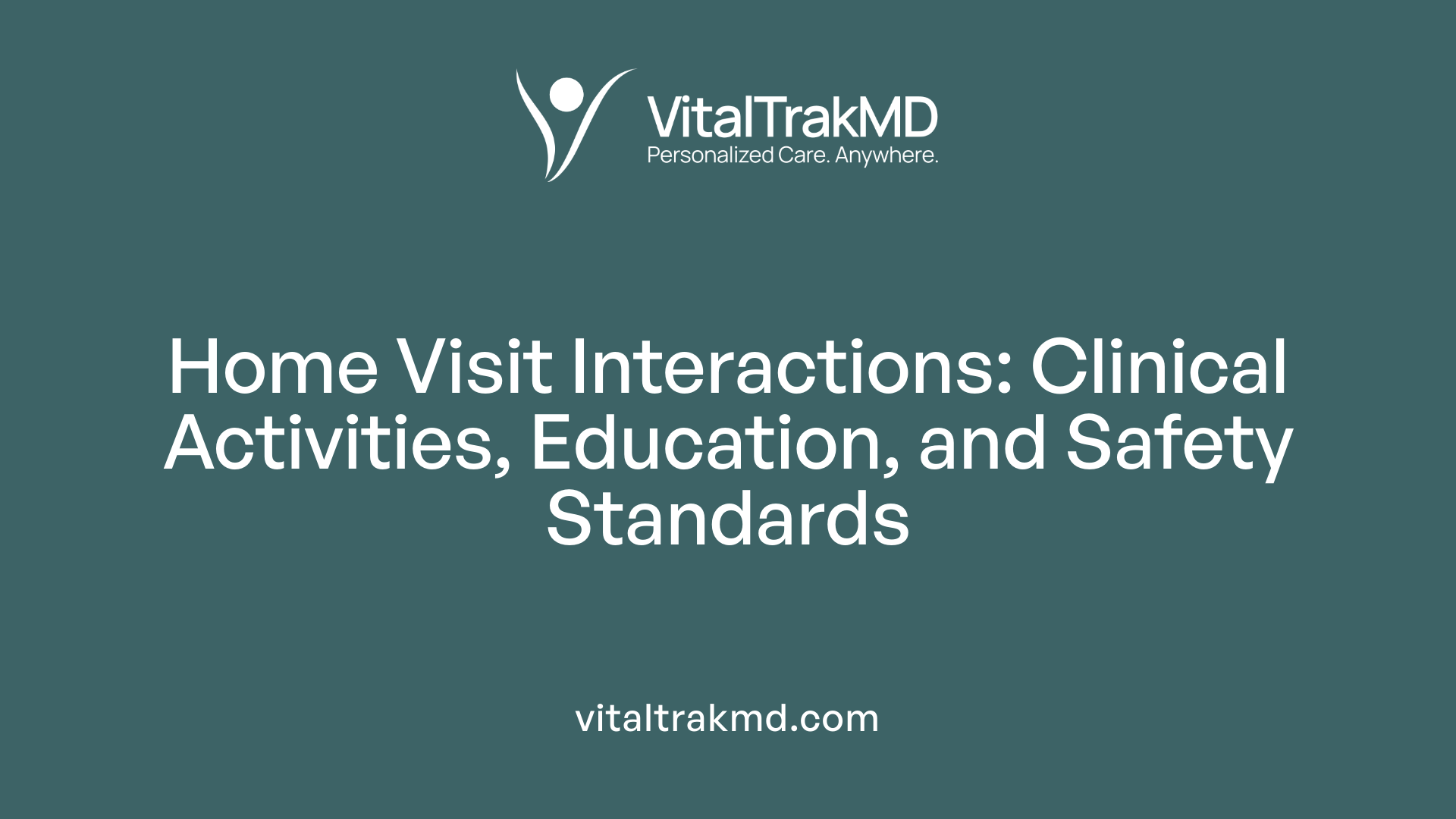What to Expect During In-Home Visits from Hybrid Care Providers

Understanding the New Landscape of In-Home Visits
In-home healthcare visits facilitated by hybrid care providers are revolutionizing how patients receive medical services. Combining in-person assessments with virtual consultations, this integrated approach aims to enhance access, safety, and quality of care, especially for populations with mobility challenges or those living in remote areas. This article explores what patients can expect during these visits, the preparation involved, the technology utilized, and how care standards are maintained to deliver seamless, equitable, and effective treatment at home.
Preparing for Your In-Home Healthcare Visit

How should patients prepare for an in-home healthcare visit?
Preparing effectively for an in-home healthcare appointment can help ensure a smooth and beneficial experience. Patients are advised to gather all relevant medical supplies, medications, and dosage instructions and keep a detailed list of emergency contacts and healthcare providers nearby. This information should be easily visible during the visit for quick reference.
Confirming the appointment ahead of time is crucial. Involving caregivers or family members who support the patient can also enhance the visit's effectiveness. It’s beneficial to ensure the home environment is safe by removing potential hazards such as clutter or loose rugs. Installing accessibility features like grab bars, ramps, or stairlifts can improve safety and independence.
Organizing living spaces and setting up areas for comfort will make the environment more conducive to assessment and care activities. This includes arranging seating, ensuring good lighting, and having necessary medical equipment like blood pressure monitors or thermometers on hand.
Clear communication with the care team about specific needs or concerns is essential. Patients should review their care plan, clarify what services to expect, and discuss any questions about costs or scheduling. It’s also helpful to prepare an overview of current health issues, medications, and social or functional challenges.
Being well-prepared not only facilitates more accurate assessments but also fosters trust and collaboration between patients and healthcare providers. This proactive approach to in-home care creates a safer, more comfortable environment conducive to high-quality healthcare delivery.
Comprehensive In-Home Assessment and Digital Setup
During in-home visits from hybrid care providers, several crucial steps ensure a thorough and effective evaluation. The process begins with an initial health assessment, where providers review the patient’s medical history, current health conditions, and medication regimen. Simultaneously, they conduct a home safety evaluation to identify any hazards that could impact health or safety.
Education plays a vital role; providers inform patients about what to expect during virtual visits, how to use telehealth devices, and the importance of maintaining privacy and security. This helps increase comfort and digital literacy, making subsequent virtual interactions smoother.
A significant part of the visit involves setting up and testing telehealth equipment. Providers assist in configuring devices such as tablets, remote monitoring sensors, and ensuring reliable Wi-Fi connectivity. They verify that all technology functions correctly, conduct test calls or video conferences, and troubleshoot any issues on the spot.
Coordination with technical support teams is often necessary if challenges persist. Providers may use digital tutorials or handouts to guide patients through device operation. Visual aids and simple instructions support ongoing self-use.
Throughout the visit, clinicians actively engage with the patient, performing physical examinations where hands-on assessments are necessary. They identify cases requiring in-person visits and establish follow-up plans accordingly.
After the appointment, providers document findings meticulously in electronic health records, plan future care, and proactively address potential barriers like limited digital literacy or connectivity issues. This comprehensive approach empowers patients, enhances trust, and integrates virtual technology seamlessly into their care journey.
Technology and Digital Tools in Home Healthcare
In home healthcare, a range of advanced digital tools are transforming how care is delivered outside traditional settings.
Video conferencing platforms are fundamental, allowing healthcare providers to conduct virtual consultations easily and efficiently. These platforms support real-time visual communication, making remote doctor visits, follow-ups, and health check-ins more personal and effective.
Remote patient monitoring devices also play a vital role. Wearable sensors and wireless cuffs can continuously track vital signs such as heart rate, blood pressure, and oxygen saturation. This data is transmitted directly to clinicians, enabling proactive management of chronic conditions like heart failure or diabetes.
Health apps are increasingly common for medication management, disease tracking, and health education. Patients can set medication reminders, log symptoms, and access educational resources, which enhances engagement and adherence to treatment plans.
Smart home technologies contribute to safety and independence. Devices like voice-activated assistants help patients control home environments, while safety sensors monitor activity levels and detect falls, alerting caregivers or emergency services if needed.
Equally important are secure data systems and cybersecurity measures. Protecting sensitive health information with encryption, secure login credentials, and regular system updates is critical to maintain patient privacy and comply with healthcare regulations.
Overall, these technological innovations support a more accessible, efficient, and patient-centered home healthcare system, helping reduce hospital visits and improve health outcomes.
Activities, Interactions, and Care Standards in the Home Setting
 During in-home visits, healthcare providers engage in a variety of activities designed to assess and support the patient’s health directly within their living environment. These assessments often include checking vital signs such as blood pressure, heart rate, and oxygen levels, along with monitoring specific health concerns like wounds or chronic condition management. Providers may also perform procedures like wound dressing, medication administration, or support for intravenous therapies tailored to the patient’s medical needs.
During in-home visits, healthcare providers engage in a variety of activities designed to assess and support the patient’s health directly within their living environment. These assessments often include checking vital signs such as blood pressure, heart rate, and oxygen levels, along with monitoring specific health concerns like wounds or chronic condition management. Providers may also perform procedures like wound dressing, medication administration, or support for intravenous therapies tailored to the patient’s medical needs.
Patient and caregiver education plays a central role during these visits. Healthcare professionals teach caregivers techniques to manage medications, perform wound care, and operate medical devices safely. They also give guidance on disease management, recognizing warning signs, and maintaining medication adherence. Demonstrating procedures and providing clear instructions help caregivers feel confident and prepared to manage ongoing care.
In addition to clinical tasks, in-home visits often incorporate physical, occupational, or speech therapy sessions to assist with mobility, communication, or rehabilitation goals. Caregivers typically handle routine tasks such as bathing, grooming, assistance with mobility, and household chores. They may also receive training from healthcare providers on safe care practices.
Ensuring safety, confidentiality, and high-quality care are fundamental standards in home-based healthcare. Providers follow protocols to prevent falls and manage infection risk. Maintaining patient privacy and data security during assessments and communication is prioritized. Through careful coordination and adherence to standards, home visits aim to support recovery, optimize chronic disease management, and keep patients safe and comfortable in their familiar environment.
Ensuring Care Quality and Safety Standards
 During in-home visits, healthcare providers prioritize maintaining high-quality care through adherence to evidence-based protocols. This ensures that each patient receives standardized and effective treatments tailored to their specific conditions.
During in-home visits, healthcare providers prioritize maintaining high-quality care through adherence to evidence-based protocols. This ensures that each patient receives standardized and effective treatments tailored to their specific conditions.
Thorough documentation and progress tracking are essential components of quality assurance. Providers systematically record assessments, interventions, and patient responses, enabling continuous monitoring of health outcomes and facilitating regulatory compliance.
Safety precautions are rigorously implemented to prevent falls, medication errors, and other adverse events. This involves environmental assessments, safety education, and cautious medication management, especially for vulnerable populations like the elderly.
Upholding patient autonomy and confidentiality remains a cornerstone of home care. Providers engage patients and their families in decision-making processes, respecting cultural preferences and ensuring informed consent. Privacy is safeguarded during all interactions.
Frameworks such as the 4Ms — What matters, Medications, Mentation, and Mobility — guide comprehensive, patient-centered care during visits. These assist clinicians in addressing individual goals, managing medications safely, supporting mental health, and improving functional mobility.
Overall, the standards during in-home care combine clinical best practices, precise documentation, safety measures, and respect for patient rights to ensure effective and safe healthcare delivery in the home setting.
Search terms: Care standards during home visits, patient safety protocols, regulatory compliance in home care, care frameworks for home visits.
Managing Care Delivery and Ensuring Continuity in Hybrid Models

How is care delivery managed in hybrid healthcare settings?
In hybrid healthcare systems, care delivery is carefully coordinated by combining in-person and virtual services, tailored to each patient's unique needs. This approach utilizes a range of digital tools, including remote monitoring devices, telehealth platforms, and virtual consultation software, which enable continuous communication between healthcare providers, patients, and their caregivers.
Effective planning of workflows and scheduling plays a crucial role. Dedicated virtual appointment times and clear care pathways help ensure a seamless transition between face-to-face visits and remote interactions. Hospitals and clinics often develop specific protocols to manage hybrid services efficiently.
Data analytics and outcome measurement are integral to maintaining high standards of care. Regular monitoring of patient health metrics, feedback from patients, and quality assessments help healthcare organizations identify areas for improvement. This data-driven approach supports ongoing safety and satisfaction.
Overall, implementing purposeful organizational strategies that embed technology, flexible scheduling, and adaptive workflows ensures quality, safety, and resource efficiency. This creates a truly integrated care experience that optimizes clinical outcomes while accommodating evolving patient needs.
Expectations and Future of Hybrid In-Home Care

What should patients expect during an in-home hybrid healthcare visit?
During an in-home hybrid healthcare visit, patients typically experience a blend of virtual consultations and direct, face-to-face interactions based on their individual health requirements. They will be guided on how to operate any necessary technology, with support available to help ensure a seamless process. This may include practice runs for using video conferencing tools or remote monitoring devices.
Healthcare providers clearly communicate both the advantages and limitations of telehealth, emphasizing situations where in-person care remains essential. Privacy and security concerns are addressed to foster trust. Patients often receive educational materials and technical support to empower them to navigate virtual visits confidently.
The goal of this approach is to improve healthcare access, reduce waiting times, and enhance patient satisfaction by offering flexible, personalized care. Overall, patients can expect a respectful, empathetic experience that prioritizes communication, safety, and a supportive environment.
Embracing the Future of Home Healthcare
In-home visits by hybrid care providers represent a significant advancement in healthcare delivery, combining the best aspects of in-person and virtual care to enhance patient access, safety, and satisfaction. As technology evolves and care models become more integrated, patients can expect more personalized, flexible, and accessible services designed to meet diverse health needs. Ongoing efforts to promote health equity, ensure safety standards, and leverage innovative digital tools will continue to shape the future of in-home healthcare, making it more patient-centered and effective.
References
- Introduction to using telehealth in hybrid care
- How the Hybrid Care Model is Transforming Patient Access
- Preparing patients for hybrid care | Telehealth.HHS.gov
- Hybrid Care: Making the Case for Telehealth in Every Patient Room
- What is a Hybrid Healthcare System: A Definition + Solutions - Mend
- Virtual Visits in Home Health Care for Older Adults - PMC
- Aetna Healthy Home Visit Program - Medicare Plans
- Remote vs In-home Physician Visits for Hospital-Level Care at Home
Recent articles
Want to Feel Better and Live Healthier?
Join hundreds of patients taking control of their health with personalized care that fits their life – not the other way around.
Rated 4.8/5 by 32+ customers







